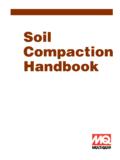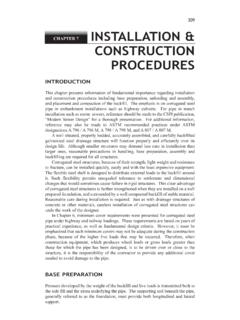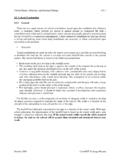Transcription of BEDDING IN DIFFERENT SOILS - Buckeye Tractor
1 RAISED-BED HANDBOOK Outlined bed shaping principles apply to any scale of application. Regarding tractors and equipment, most references are given to smaller-scale operations, typically with one-row or two-row equipment. A ONE-PAGE REVIEW TO START QUICK 1) Bed shapers can be used with DIFFERENT soil -working strategies in DIFFERENT SOILS for the finest seedbed. Form beds before planting in seedbed soil . Form beds early for early planting or to avoid excessive tillage before BEDDING . 2) To form beds in loose seedbed soil , prepare field with conventional primary and secondary tillage equipment. Till deep enough for the bed height. Work-in field residue after harvest for most decomposition.
2 If this did not occur, cut-up and work-in residue more, if needed. Field should be clean with no residue before bed shaping. This method is most common. 3) To form primary beds, prepare field with primary tillage to loosen soil and cut-up and work-in residue. Primary BEDDING helps bury residue. Field should basically appear clean after primary BEDDING . Bed height should be sufficient to allow for settling with time and weather. 4) Finish primary beds before planting with bed shapers equipped with tillage attachments. Tilling and leveling bed tops produces a fine seedbed. Additional soil should not be cut out of the furrows. 5) Sub-surface drip tape can be applied with the bed shaper.
3 Various common irrigation, fertilizing and weed control methods are compatible with beds and bed shapers. 6) Be practical about bed height since higher is not necessarily better. Balance bed height with Tractor size and/or tillage capabilities. If looking for a suggestion, a 6-in bed height is very practical and functional in North American climates. Consider a 4-in bed height for smaller tractors, which has less demand on tillage depth. Tractor power requirement most influences bed height, or vise versa. Hint: If tillage depth is insufficient with a higher bed and time is short, change to a lower bed and plan for a higher bed later. Then consider appropriate Tractor power, the bed shaper, tillage equipment or primary BEDDING methods for more bed height.
4 7) Set bed shaper center-to-center width the same as Tractor wheel track width. When forming beds in the field, bed row spacing is also typically the same as the Tractor wheel track. Bed row spacing less bed top equals the furrow width. Furrow width need only be wide enough for Tractor wheels or can be wider for people walking in the furrows. Wide or narrow furrows can provide various DIFFERENT benefits. 8) The bed top is usually equal-to or less-than the width in-between the Tractor tires. Set the bed top at an appropriate width for planned row spacing(s). For most efficiency, coordinate DIFFERENT row spacings with one bed size. Many common crops are planted in one or two rows per bed.
5 For multiple crop rows, be sure outside rows are not too close to the bed corner. A particular bed top width may be needed for plastic mulch. Further reading will reveal many more common or not-so-common ideas and methods. 2 BEDDING IN DIFFERENT SOILS Use raised beds in nearly any soil . soil preparation methods before, during or after bed shaping can vary since DIFFERENT SOILS can be appropriately managed for the finest seedbed. Shaping may be done after conventional tillage to prepare the seedbed. Or shaping may be done earlier with soil -working attachments integrated with bed shapers. Sandy soil offers natural drainage properties, easy workability and a friendly environment for plant growth.
6 More-blended SOILS with organics also have nutritional benefits. SOILS with moderate amounts of clay are very common and more-particular tillage preparation may be preferred, compared to sand. Heavy clay soil still offers a more difficult growing environment, but principally benefits from raise beds. All-organic (muck) soil is highly unique, or difficult, to work with, depending on perspective. This soil is generally avoided for raised beds and this handbook does not fully cover it. Growers often take advantage of SOILS that are conventionally easiest to grow specialty crops in. Raised beds do not necessarily equalize soil types, but the benefits of moisture control are universal, providing significant management controls across many SOILS .
7 Assuming any soil (except muck) is prepared to seedbed condition, tilled the proper depth for the bed height and dry, it flows and forms equally well for bed shaping. In reality, management of soil moisture in DIFFERENT SOILS primarily influences BEDDING practices to cultivate the finest seedbed and at the preferred time. Demands on Tractor power, tillage equipment and timing are relative to soil type. Lighter SOILS are generally tillable with more moisture and more tolerant to error. Heavier SOILS often require more tillage work, power or patience. Avoiding late or excessive tillage is important to plant on time. soil management and moisture control is essential for early planting.
8 In contrast, late planting allows much more flexibility for tillage. Skillful tillage is timeless in agriculture. Consult local agricultural services if needed for personal assistance. Advice from other growers or direction from previous generations is priceless. In general, tillage in wet conditions is easily pointless, likely increasing compaction or making clods. Primary tillage loosens soil to sufficient depth for the bed height. Secondary tillage prepares the seedbed on top and does not till deep. Moist soil is generally best for any tillage to shatter clods, fracture hard soil or ease penetration. Patience with skillful field work is essential. Basic tillage know-how is further reviewed in this handbook.
9 Several bed shaping methods allow working with DIFFERENT SOILS or DIFFERENT conditions. Bed shaping after conventional seedbed preparation is basically an extra step before planting. This is sufficient and quick for new raised-bed users and best takes advantage of conventional equipment and tillage know-how. Other methods feature bed shaping earlier for less overall field work. Early BEDDING cuts furrows without excessive tillage and avoids turning wet, chunky soil out of the furrow into the seedbed at planting time. This is a particular benefit with higher beds (hint, deeper furrows) or in moderate SOILS with some clay, since moving a lot of soil for bed shaping can conflict with appropriate handling of the soil (moisture management).
10 High soil displacement may matter less in sand but can make a cloddy mess in heavier SOILS . Early bed 3 shaping allows soil to mellow naturally. These primary beds are usually finished with bed shapers equipped for tilling the beds as well as shaping into final form. Less field work allows early planting as well. Bed height and Tractor power are relative. Higher beds generally require more Tractor power for bed shaping or the tillage before it. Besides the soil moisture management benefits covered above, early BEDDING methods can require less Tractor power. This can be a particular advantage for forming higher beds or using smaller tractors. BED SHAPING METHODS Several common or practical bed shaping methods allow forming the best seedbed in DIFFERENT types of soil .






